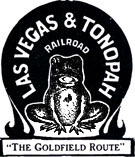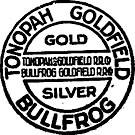Rhyolite
Perhaps one of Nevada's best known ghost towns, Rhyolite was established in November 1904 following discoveries at nearby Bullfrog. In January 1905, Rhyolite was officially platted and a tent city formed. Before long, a substantial hotel was built and an 'unofficial' post office opened. An official post office opened in May and on June 26, an efficient water system was completed, supplied the town with an abundance of water. Four stage lines served Rhyolite, and in early 1906 the first school opened.
Rhyolite peaked between 1907 and 1908, with its population estimated to have reached 8,000 to 12,000. Two newspapers - the Rhyolite Herald and Bullfrog Miner - served the city and three railroads connected Rhyolite to Tonopah, Goldfield, and Las Vegas. A number of impressive concrete and brick buildings were erected in the city, and a series of 400 electric streetlights were installed.
More than eighty-five mining companies were active in the hills near Rhyolite during these prosperous years, and the most productive mine was the Montgomery-Shoshone mine. Following the financial panic in 1907, however, most of these folded and Rhyolite began to decline in 1908. On August 19, a fire leveled the red light district and parts of the eastern business district. By the end of 1909, less than 1,000 people were left. The Montgomery-Shoshone mine closed permanently in March 1911. The Las Vegas & Tonopah and the Bullfrog-Goldfield Railroads were consolidated in 1914, and continued to serve Rhyolite until Fall 1918. By 1920, 14 people still called Rhyolite home, and by 1924, Rhyolite was completely abandoned.
Small amounts of work were done during the next decades, mostly on old tailings piles. The massive building remains were left to the mercy of the harsh Amargosa winds. A casino, the Rhyolite Ghost Casino, was operated in the late 1930s by Wes Westmoreland in the old Las Vegas & Tonopah Depot and in later years Tom Kelly's Bottle House was used as a museum. In more recent times, open pit mining development has occured around the townsite. In 1984, the Goldwell Open Air Museum was created by Albert Szukalski, a Belgian artist. Today the Rhyolite Historic Area is managed by the Bureau of Land Management.


















































































